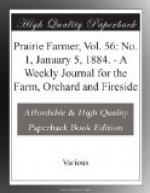[Illustration: Joseph Farwell Glidden.]
Mr. Glidden has held several local offices of trust and honor and enjoys in a marked degree the esteem and confidence of the citizens of his neighborhood and county. The rapid accumulation of property of late years, through his barb-wire patents and business, gave him the means to gratify his feelings of public spirit, and in consequence the town of DeKalb has benefited greatly at his hands. Its leading hotel and many other buildings are the work of his enterprise. Mr. Glidden has never lost the simple manners of the farm. He is unostentatious, quiet, genial, and at his hotel makes everybody feel as much at home as though enjoying the hospitalities of his private house. His kindly, firm, and intelligent face is well shown in the accompanying portrait, though, as is usually the case, the hand of the artist has touched his features more lightly than has the hand of time.
* * * * *
Few names are now more widely known among the land holders of the country than that of Joseph F. Glidden, the unpretending gentleman whose life we have briefly sketched. It was his fortune to seize upon an idea, and push it to development, which has not only given him fame and fortune, but which has enriched many others and saved many millions of dollars to the farmers of America. He has not only founded a mammoth industry, but he has revolutionized an economic system of the world. By his ingenuity and perseverance the fencing system of a pastoral continent has been reduced to a minimum of expense and simplicity. Not that he individually has accomplished all this, but as the patentee of the first really successful barb-wire fence, he laid the solid foundation for it all.
* * * * *
The first application for a patent for the Glidden barb was filed October 27, 1873. For some weeks previous to this date Mr. Glidden had had in his mind the idea of a barb of wire twisted about the main wire of the fence, leaving two projecting points on opposite sides. He made some of these by hand with the aid of pinchers and hammer. He strung two wires between two trees and twisted them together with a stick placed between them. A pair of cutting nippers was the next addition to his “kit” of tools. His next means for twisting the two wires together was the grindstone—attaching one end of the wire to shaft and crank, the others




